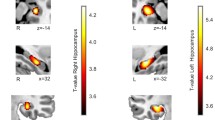Abstract
THE ability to respond to unexpected stimuli (the 'orienting response') is a fundamental characteristic of mammalian behaviour1, but the brain mechanisms by which novelty is detected remain poorly defined. Electrophysiological recordings of scalp and intracranial event-related potentials (ERPs) have shown that novel stimuli activate a distributed network involving prefrontal and posterior association cortex2–6. In addition, ERP7,8 and single-neuron9,10 recordings, as well as neuroimaging11 and modelling12 studies, have suggested that temporal cortical regions, including the hippocampus, are also involved. To examine further the role of the medial temporal lobe in novelty processing, I measured physiological responses to novel auditory and tactile stimuli in patients with damage to the posterior hippocampal region. In normal control subjects, unexpected novel stimuli produce a characteristic ERP signal, accompanied by an autonomic skin response. Both responses are reduced in hippocampal lesion patients, whereas the response to expected control stimuli is unaffected. Thus the hippocampal region, in addition to its known role in memory formation, is an essential component of the distributed limbic–cortical network that detects and responds to novel stimuli.
Similar content being viewed by others
References
Sokolov, E. N. Annu. Rev. Physiol. 25, 545–580 (1963).
Knight, R. T. Electroenceph. Clin. Neurophysiol. 59, 9–20 (1984).
Knight, R. T., Scabini, D., Woods, D. L. & Clayworth, C. C. Brain Res. 502, 109–116 (1989).
Yamaguchi, S. & Knight, R. T. J. Neurosci. 11, 2039–2054 (1991).
Halgren, E. et al. Electroenceph. Clin. Neurophysiol. 94, 191–220 (1995).
Baudena, P., Halgren, E., Heit, G. & Clarke, J. M. Electroencephal. Clin. Neurophysiol. 94, 251–264 (1995).
Halgren, E. & Marinkovic, K. in The Cognitive Neurosciences (ed. Gazzaniga, M. S.) 1137–1151 (MIT Press, Cambridge, MA, 1995).
Scabini, D. & McCarthy, G. Soc. Neuroscience (abstr.) 19, 564 (1993).
Rolls, E. T., Cahusac, P. M. B., Feigenbaum, J. D. & Miyashita, Y. Exp. Brain Res. 93, 299–306 (1993).
Miller, E. K., Li, L. & Desimone, R. Science 254, 1377–1380 (1991).
Tulving, E., Markowitsch, H. J., Craik, F. I. M., Habib, R. & Houle, S. Cerebral Cortex 6, 71–79 (1996).
Metcalfe, J. Psychol. Rev. 100, 3–22 (1993).
Squires, N. K., Squires, K. C. & Hillyard, S. A. Electroenceph. Clin. Neurophysiol. 83, 387–401 (1975).
Courchesne, E., Hillyard, S. A. & Galambos, R. Electroenceph. Clin. Neurophysiol. 39, 131–143 (1975).
Polich, J. & Squires, L. R. Electroenceph. Clin. Neurophysiol. 86, 408–417 (1993).
Onofrj, M. et al. Neurology 42, 1762–1767 (1992).
Treves, A. & Rolls, E. T. Hippocampus 4, 374–391 (1994).
von Restorff, H. Psychol. Forsch. 18, 299–342 (1933).
Karis, D., Fabiani, M. & Donchin, E. Cogn. Psychol. 16, 177–216 (1984).
Goldman-Rakic, P. S., Selemon, L. D. & Schwartz, M. L. Neuroscience 12, 719–743 (1984).
Van Hoesen, G. W., Morecraft, R. J. & Semendeferi, K. in Neuropsychiatry (eds Fogel, B. S., Schiffer, R. B. & Rao, S. M.) 113–143 (Williams and Wilkins, Baltimore, 1996).
Friedman, H. R. & Goldman-Rakic, P. S. J. Neurosci. 14, 2775–2788 (1994).
Risold, P. Y. & Swanson, L. W. Science 272, 1484–1486 (1996).
Eichenbaum, H., Otto, T. & Cohen, N. Behav. Brain Sci. 17, 449–518 (1994).
Richardson, B. C., Eberling, J. C., Knight, R. T. & Jagust, W. J. Neurology 42, 170 (1992).
De Renzi, E., Zambolin, A. & Crisi, G. Brain 110, 1099–1116 (1987).
von Cramon, D. Y., Hebel, N. & Schuri, U. Brain 111, 1061–1077 (1988).
Woods, D. L., Knight, R. T. & Scabini, D. Cogn. Brain Res. 1, 227–240 (1993).
Renault, B., Ragot, R., Lesevre, N. & Remond A. Science 215, 1413–1415 (1982).
Gutrecht, J. A. J. Clin. Neurophysiol. 11, 519–524 (1994).
Author information
Authors and Affiliations
Rights and permissions
About this article
Cite this article
Knight, R. Contribution of human hippocampal region to novelty detection. Nature 383, 256–259 (1996). https://doi.org/10.1038/383256a0
Received:
Accepted:
Issue Date:
DOI: https://doi.org/10.1038/383256a0
- Springer Nature Limited
This article is cited by
-
Neural evidence for attentional capture by salient distractors
Nature Human Behaviour (2024)
-
Curiosity: primate neural circuits for novelty and information seeking
Nature Reviews Neuroscience (2024)
-
Children’s inhibition skills are associated with their P3a latency—results from an exploratory study
Behavioral and Brain Functions (2022)
-
Deficient Novelty Detection and Encoding in Early Alzheimer’s Disease: An ERP Study
Brain Topography (2022)
-
Learning task-state representations
Nature Neuroscience (2019)





